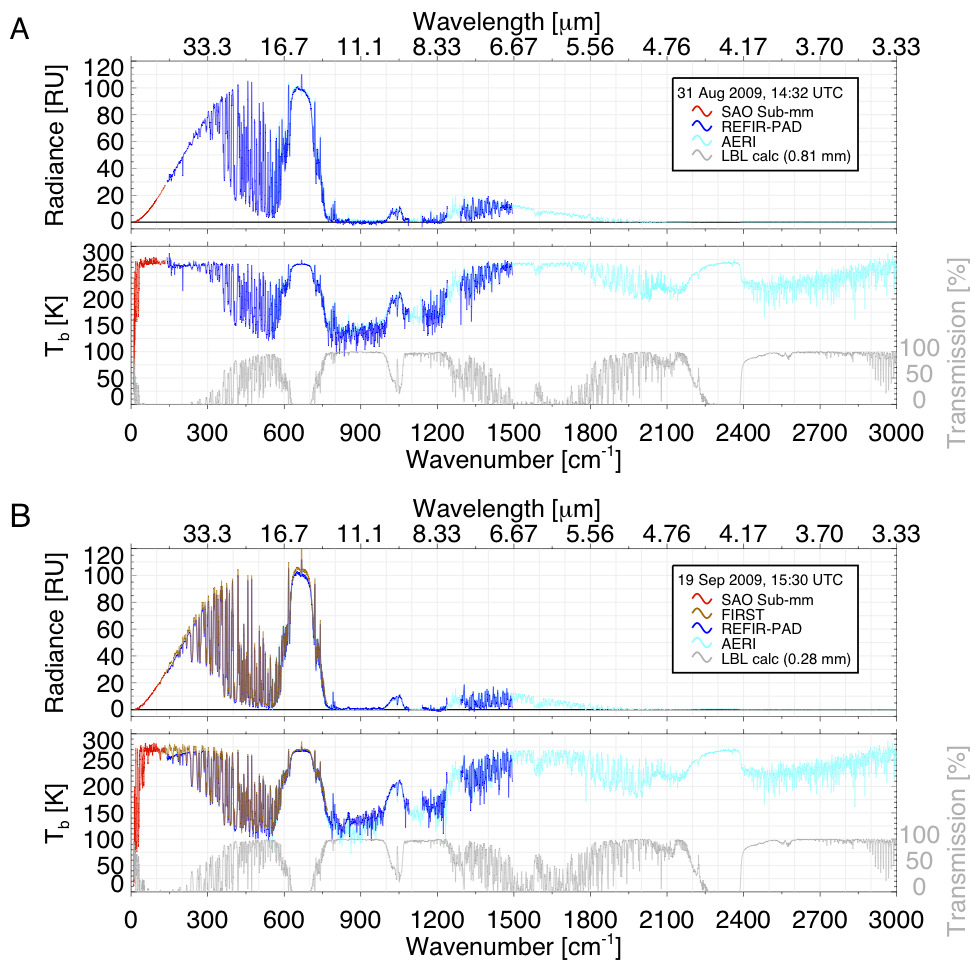First Ground-Based Spectral Observations of the Entire Infrared Band
Submitter:
Turner, David D. — NOAA Global Systems Laboratory
Mlawer, Eli J. — Atmospheric and Environmental Research
Area of research:
Radiation Processes
Journal Reference:
Science
General circulation models (GCMs) are used to simulate the Earth’s climate and to investigate how different perturbations may impact the climate over time. These models require accurate representation of the physical and dynamical processes that occur within the atmosphere. One of these processes is the emission and absorption by gases in the atmosphere. The far-infrared (16–100 µm) is a particularly important part of the electromagnetic spectrum, as nearly 40% of the outgoing longwave radiation emitted by the planet is in this spectral region; most of this emission comes from the middle and upper troposphere. However, strong water vapor absorption makes the atmosphere opaque in the far-infrared at most surface locations, which has made it challenging to use spectrally resolved measurements to evaluate our knowledge of the properties of atmospheric absorption sources in this spectral region. This, in turn, inhibited the development of instruments that measure spectrally resolved radiation in the far-infrared. This resulted in a larger uncertainty in the radiative transfer models in this spectral region, which translates into significant uncertainties in radiative processes in the middle-and-upper troposphere.
Impact
Advances in far-infrared and microwave measurement technologies led to the conduction of the Radiative Heating in Underexplored Bands Campaigns (RHUBC), which were targeted at improving our knowledge of far-infrared radiative processes. There were two phases to RHUBC: the first occurred at the ARM site in Barrow, Alaska, in 2007, while the second was conducted on a mountain, Cerro Toco, in northern Chile in 2009. The results from RHUBC-I led to a substantial change (factor of 2) in the strength of the water vapor continuum absorption model in the far-infrared, as well as spectroscopic changes to the widths of many water vapor absorption lines in this region. These changes to the infrared radiative transfer model resulted in significant changes in the longwave heating rate profile in a clear sky atmosphere and, when implemented in the Community Earth System Model (CESM v1), resulted in both a radiative and dynamic response in the model. However, the minimum amount of precipitable water vapor (PWV) during RHUBC-I was 0.95 mm, and thus the atmosphere at wavelengths longer than 26 µm remained opaque despite the relatively dry conditions. Thus, changes to the water vapor continuum between 26 and 1000 µm, important to the radiative balance of the planet, were inferred from other wavelengths and needed validation.
RHUBC-II was conducted at an altitude of 5.3 km in the Atacama Desert, and the minimum PWV observed during the experiment was 0.22 mm. This low-PWV, low-pressure (530 mb) environment resulted in the atmosphere being significantly more transparent in the far-IR than in RHUBC-I. Furthermore, a suite of four Fourier Transform Spectrometers were used to provide simultaneous spectrally resolved radiance measurements across the entire terrestrial thermal spectrum (3–1000 µm), including semi-transparent microwindows on either side of the strong water vapor absorption band in the far-infrared. This is the first time such a data set has been collected from a ground-based site.
Summary
The unique RHUBC-II data support the changes made to the radiative transfer model based upon RHUBC-I analysis and thereby support the results that the RHUBC-I changes had on a GCM simulation. These data also suggest that some additional modifications need to be made, especially in the sub-millimeter portion of the spectrum, but the impact on a GCM simulation of these additions is expected to be much smaller than the impact from the modifications based on analysis of RHUBC-I measurements.


